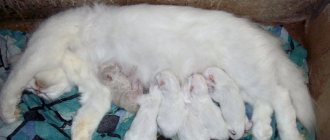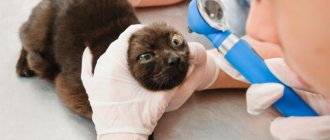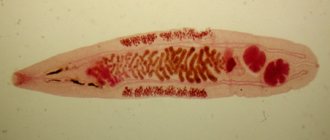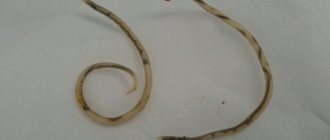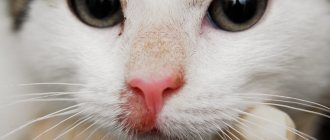Save the article:
The inflammatory process in the mammary glands of a cat is a serious and serious disease that requires timely diagnosis and immediate treatment. Veterinarians identify several causes of mastitis in cats. The disease occurs in different forms, but in each case the animal needs veterinary care. Owners of cats need to know the basic methods of prevention in order to prevent the development of the problem and its unpleasant consequences.
Causes of mastitis in cats
global $ads_google; //data-ad-slot=”2475549904″ $ads_google = empty($ads_google) ? false : true; ?> if ($ads_google == false) {?>
$ads_google = true; ?> } ?>
Factors that initiate mammary gland pathology can be very different. They concern both the physiology of the animal itself and environmental conditions. The claim that mastitis only occurs in lactating cats and does not occur in cats that have been neutered is a misconception. Practice shows that mastitis occurs in cats in any condition. Precipitating conditions include:
- Injuries, mechanical irritation in the gland area.
- Infection of tissues through cracks in the nipples.
- Gynecological and urological diseases.
- Stagnation of milk due to early weaning of kittens from their mother.
- Blockage of the milk ducts for physiological reasons.
- Stillbirth of cubs in the same litter.
- Complications after cesarean section.
- Violation of hormone synthesis during estrus, false pregnancy.
The development of mastitis in cats is facilitated by hypothermia and a weakened immune system.
Complications
The main complications of mastitis include the development of an abscess or gangrenous form. With such forms of flow, the risk of damage to other tissues around the mammary gland (skin, muscles) increases. Milk becomes completely unsuitable for feeding kittens; they must be switched to a formula - a cat's milk substitute and fed by hand. Treatment of such forms of mastitis may involve surgery to wash out the pus and install a drainage system, removing necrotic tissue. If the entire breast is affected, complete excision of the breast tissue may be recommended. If left untreated, the cat may die due to sepsis.
Forms and types of mastitis
The nature of the process depends on the symptoms and the type of pathogen. Mastitis in cats is classified into purulent, catarrhal, serous, fibrous, hemorrhagic, gangrenous. Each form is characterized by its own degree of severity, while one variety can transform into another.
Purulent mastitis
Pathogenic flora causes the accumulation of pus in the mammary cavities, which is released along with milk. With purulent mastitis, the presence of blood in the discharge is often noted. The mammary glands swell, turn red, and become noticeably hot and painful.
Further development of the disease causes general hyperthermia (a rise in temperature above normal), intoxication and depressed behavior. If pus appears in the milk, the kittens are separated from their mother to avoid poisoning.
Fibrinous
Changes in connective tissue provoke complete blockage of the milk ducts. There is an increase in lymph nodes, severe hyperemia and increased density of the mammary glands.
Any touch to them causes pain in the cat. With fibrous mastitis, intoxication of the body begins. Behavioral symptoms appear: the cat becomes lethargic and passive.
Serous
This type of mastitis in cats is characterized by general or partial redness of the integument and the release of a grayish secretion from the nipples.
If a female feeds kittens, the secreted milk acquires a thinner consistency, flaky impurities are noticeable in it, and an unpleasant odor is felt. The skin covering the glands thickens or swells. With serous mastitis, the mammary glands increase in size, and the cat indicates pain upon palpation.
global $ads_google; //data-ad-slot=”2475549904″ $ads_google = empty($ads_google) ? false : true; ?> if ($ads_google == false) {?> $ads_google = true; ?> } ?>
Catarrhal
With this form of the disease, blockage of the ducts is observed. This provokes stagnation of milk secretion in the glands and increased proliferation of pathogenic microorganisms. Milky discharge has a characteristic unpleasant odor. Clots in the form of flakes are noticeable in the milk. Symptoms of catarrhal mastitis resemble a picture of a serous form.
Hemorrhagic
Due to minor hemorrhages in the tissues of the glandular organ, blood enters the ducts and is excreted with milk. The milk-secreting organs swell and become painful. From the outside, hematomas are visually detected.
Symptoms of mastitis can affect one or more glands at the same time.
Gangrenous
If the inflammation is not treated, necrosis begins in the mammary glands. Local tissue rejection becomes general and gangrene begins. External symptoms of gangrenous mastitis are blue, purple, brown, black spots. Painful ulcers and bleeding appear on the affected areas.
Symptoms
The first symptoms of the disease are difficult to notice, so you need to be an attentive and caring owner - constantly monitor the behavior of your pet.
- The appearance of swelling, compaction and redness in the breast area.
- The gland is hot to the touch and touching it causes pain and discomfort in the cat.
- In the presence of a bacterial infection, discharge of a different nature appears from the mammary gland (purulent, cheesy, cloudy), sometimes an impurity in the form of blood may appear.
- Increased body temperature and lethargic state of the animal.
How to determine what form of mastitis a cat has
Serous:
- one or more lobes of the mammary gland are swollen;
- milk lobes are hot to the touch;
- dense gland;
- the cat does not feel anxious, has a mild pain syndrome, the animal allows itself to be examined, does not meow;
- body hyperthermia may be absent;
- discharge from the nipples is initially yellowish and transparent, then resembles diluted milk with flake-like impurities.
Catarrhal:
- the structure of glandular tissue changes;
- milk turns into flakes that clog the ducts in the nipples;
- milk stagnates and curdles, because of this nodules appear around the nipples, they can be felt upon palpation;
- There may be no body hyperthermia;
- after feeding or pumping, the nodules resolve;
- the cat does not worry and does not experience pain.
Purulent:
- visible decrease in the volume of milk produced;
- discharge from the nipples is cloudy and purulent, has an unpleasant odor;
- the affected lobes of the mammary gland are very swollen and reddened;
- the cat has a fever;
- the animal is oppressed;
- due to severe pain, the cat refuses to feed the kittens, meows loudly and does not allow itself to be examined;
- in a chronic course (more than 21 days), the gland is completely filled with connective tissue, and the cat loses the ability to lactation.
Fibrinous:
- the lobes of the mammary gland appear enlarged, dense to the touch, painful;
- on palpation you can hear a crunch;
- lymph nodes located in close proximity to the diseased lobes are enlarged;
- The cat has a fever.
Hemorrhagic:
- the skin, glands and ducts become covered with hemorrhages;
- the gland is swollen and painful;
- the cat is depressed and has a fever;
- local hyperthermia (milk lobes are hot).
Gangrenous:
- change in color of the mammary glands to brown or blue;
- ulcers and bleeding appear in diseased areas;
- the cat is unconscious;
- the animal has a strong increase in body temperature.
Asymptomatic mastitis
Sometimes the disease occurs without visible symptoms. You can tell that a cat is developing mastitis by the following signs:
- kittens are malnourished and gain little weight;
- the cat is anxious during feeding and licks its mammary glands during breaks;
- kittens are worried and may have an upset stomach due to changes in milk quality.
Methods for diagnosing mastitis
The very beginning of the disease may be missed due to a blurred clinical picture. Further development contributes to a more pronounced manifestation of symptoms. Diagnosis of mastitis in a cat consists of visual examination, palpation, ultrasound and laboratory tests. After which treatment is prescribed.
Blood is taken from the animal to determine the total number of cells and hemoglobin. To determine the degree of inflammation and the pathogen, an analysis of discharge from the mammary gland is performed. This cytological study also helps to determine the nature of inflammation. A high number of dead epithelial cells indicates the fibrous, catarrhal, serous type. An increased number of red blood cells and platelets diagnoses the hemorrhagic form.
The ultrasound method helps determine the localization of the pathogenic process, the condition of the ducts and the presence of fluid in them. Ultrasound checks the condition of the glandular cavities and the tissues of the glands themselves. Diagnostics makes it possible to distinguish mastitis from less dangerous mastopathy, adenoma, and benign growth of glandular tissue.
Serous and catarrhal
One form of the disease is serous mastitis, which leads to swelling of the glands and an increase in their temperature. The nipples secrete a white-yellow fluid.
During palpation, the animal does not feel pain, which allows for a high-quality examination. The disease is characterized by redness of the skin.
- Catarrhal mastitis affects only the inner lining of the mammary glands.
- The clinical picture is the same as for serous mastitis.
- A large number of white flakes appear in the milk, which clog the ducts of the glands, which leads to stagnation of milk.
- This background is favorable for pathogenic microflora. Milk gives off an unpleasant odor.
Why is mastitis dangerous?
global $ads_google; //data-ad-slot=”2475549904″ $ads_google = empty($ads_google) ? false : true; ?> if ($ads_google == false) {?>
$ads_google = true; ?> } ?>
Purulent inflammation of the mammary glands threatens to spread to other organs without treatment and result in general sepsis. Such a serious condition is fraught not only with intoxication, but also with the death of the animal. Kittens suffer no less, receiving, at best, defective milk, and at worst, poisoned milk. The death of babies due to purulent mastitis in cats often happens.
An advanced form may require the help of a surgeon
Advanced mastitis often develops into a chronic form. In case of hypothermia or weakened immunity, the cat’s glands begin to become inflamed. The cavities that were previously filled with pus are overgrown with connective tissue. The mammary gland loses its ability to function normally. Another danger is the possible degeneration of glandular tissue. This is how tumors of both benign and malignant nature appear.
Phlegmonous and fibrinous form
The phlegmonous form is a purulent mastitis that affects adipose and connective tissue. The skin condition worsens, the temperature rises, and loss of consciousness may occur. If help is not provided in time, the cat will die.
Fibrinous mastitis is accompanied by blockage of the ducts. Symptoms: Fever, intoxication, apathy, enlarged lymph nodes and mammary glands. When you feel the inflamed areas, you can hear sounds reminiscent of crunching.
Treatment of mastitis
Conservative therapy uses antibiotics and immunocorrective medications. In more severe cases, surgical intervention is resorted to. The duration of treatment for mastitis in a cat is determined by the form of the disease:
- serous - 5-7 days;
- fibrinous - 5-10 days;
- purulent - 14 days;
- gangrenous - 25-30 days;
- hemorrhagic - 10-15 days.
Antibacterial treatment includes cephalosporins (Cefazolin, Cephalexin) or penicillins (Amikacin, Ampicillin). If a fungal infection is added to a bacterial infection, the patient is treated in parallel with antifungal drugs: Griseofulvin, Amphotericin.
When the inflammatory process goes too far, the cat is operated on: the abscessing boils are opened, the purulent contents are removed, and the cavities of the milky lobes are cleaned. In some cases, a partial or complete mastectomy (removal of the breast) is indicated. After surgery, the animal requires a long rehabilitation period.
Anesthesia
If the pain syndrome is severe, the cat is given a novocaine blockade before starting treatment. To do this, an injection is made into the fat layer between the affected area and the peritoneum with a 0.5% or 1% solution of novocaine. The dose depends on the weight of the pet: for every kilogram of weight, take 1 ml of the drug. At the same time, an antibiotic is added to the syringe. Anesthesia is repeated at intervals of two days until the pain symptom completely disappears.
Strengthening the immune system
To strengthen the body's defenses, the cat is prescribed complex dietary supplements. Vitamins and minerals support the immune system and help quickly neutralize the inflammatory focus. The vitamin preparation is fed to the animal for two months. Immunomodulators also provide support: Neoferon, Globfel, Catozal and others. The immunoglobulins and plant extracts they contain stimulate your own immunity.
Treatment of congestive form
If stagnation of milk is noted, it is necessary to carry out procedures to stimulate its outflow. Diuretics are prescribed among medications. They promote faster removal of fluid from the body, thereby slightly reducing the flow of water into the mammary glands.
global $ads_google; //data-ad-slot=”2475549904″ $ads_google = empty($ads_google) ? false : true; ?> if ($ads_google == false) {?>
$ads_google = true; ?> } ?>
Treatment of stagnant mastitis includes antiseptic compresses made from Chlorhexidine. The solution is heated to body temperature, a sterile gauze cloth is moistened in it, lightly squeezed and applied to the sore spot. Cover the compress with polyethylene and bandage it. Keep the bandage on for 10-15 minutes. An alternative to Chlorhexidine can be ichthyol or chloramphenicol ointment, infusions of medicinal herbs with an antibacterial effect.
What is mastitis
Mastitis is an inflammation of the mammary gland that occurs in all mammals, including cats.
Mastitis, mastopathy and breast tumors are completely different diseases that require different approaches to treatment.
Mastitis in most cases is caused by bacterial flora, especially pyogenic staphylococci and streptococci, as well as their associations with other types of bacteria. Less commonly, the cause of pathology may be fungal flora.
Mastitis is usually divided into:
- Lactation. They occur during the active functioning of the gland and are associated with milk production. They are characterized by the rapid development of the infectious process with the involvement of new areas, and there is also a risk of generalization and the development of septic complications. This is due to the fact that during lactation the mammary gland has a large number of natural cavities filled with milk and surrounded by fatty tissue, this is an attractive substrate for bacteria. An extensive network of milk ducts, as well as lymphatic vessels, creates good conditions for the rapid spread of microbial flora. The occurrence of lactation mastitis is preceded by lactostasis - with insufficient or untimely emptying of the gland, an increase in the number of microbial flora occurs, which is normally washed out of the ducts. Bacteria cause fermentation, as a result of which the milk curdles and the epithelium of the excretory ducts of the gland is damaged. Curdled milk and desquamated epithelium form clots that block the milk ducts, impede the outflow of milk and create favorable conditions for the development of mastitis. In parallel with the proliferation of microbes, stagnation begins in the lymphatic vessels and veins, since their thin walls are compressed by increasing edema, which further contributes to the development of infection. The lactation form of mastitis is the most common.
- Non-lactational. They develop as complications of a gland injury or a pustular skin infection against the background of an immunodeficiency state. In this case, the glandular tissue is involved in the inflammatory process for the second time, being affected by an infection that has spread from adjacent areas. The course of non-lactation mastitis is less violent, but they predispose to the occurrence of mastitis during lactation both due to changes in the anatomical structure of the gland, and due to the possible preservation of areas of inflammation and microbial flora in its tissues and ducts.
Mastitis most often affects nursing cats.
Treating cat mastitis at home
Complicated types of mastitis in cats require the help of a veterinarian. You can treat a sick pet at home only with catarrhal or serous mastitis. The owner has the power to alleviate the animal’s condition and speed up the treatment of mastitis. To do this, it is permissible to use a light stroking massage. If touching causes pain or discomfort in the cat, tactile stimulation is abandoned. Rubbing with ichthyol or camphor oil helps. The product is applied after the massage. The smeared surface is covered with film and bandaged.
When the mammary glands of a nursing cat become overfilled and tense, they resort to expressing milk. To limit secretion production, reduce the amount of water in the bowl. It is advisable to switch the cat to dry food and give water only when feeding.
The most important thing when treating mastitis in a cat is to follow all the instructions prescribed by the doctor.
When it is impossible to treat
The cat owner should recognize symptoms that indicate the inadmissibility of self-treatment at home. If at least one of them appears, you should urgently seek help from a specialist. This list includes:
- soreness and severe hardening of the glands;
- enlargement of nearby lymph nodes;
- cloudy discharge from the nipples with traces of pus and blood;
- fever, fever.
Severe disease requires medical intervention. Treatment of mastitis in such cases consists of a complex of analgesic, antibacterial, and immunomodulatory medications.
Folk remedies
It is useful for a sick cat to apply warm compresses to the area of the affected organ. Decoctions or infusions of chamomile, oak bark, sage, string, and birch leaves are used as a medicinal liquid. To prepare the drug, one tablespoon of herb or collection is poured with boiling water and infused. After filtering, a piece of gauze is moistened in the solution and applied to the sore spot. Place polyethylene on top and lightly bandage it. The procedure lasts 20-30 minutes and is repeated up to five times a day. Cabbage leaves used to treat mastitis do not have noticeable effectiveness, so they are used only for very mild forms of mastopathy.
When is an urgent need to contact a veterinarian?
Unfortunately, it is not always possible to catch mastitis at an early stage, and in the vast majority of cases this is due to the rapid development of the inflammatory process, as well as the fact that many nursing cats do not allow examination of their abdomen and mammary glands.
An urgent visit to the clinic is necessary if:
- increased cat body temperature;
- signs of intoxication appear: lethargy;
- thirst;
- lack of appetite;
- general oppression, apathy;
- is a surgical pathology;
If the cat’s temperature rises and the cat’s well-being becomes unwell, self-medication is unacceptable.
How to express milk to a cat
To express milk from a lactating female, it is recommended to use a special breast pump. If the device is not available, it is easy to make it yourself. To do this, take a plastic disposable 5 ml syringe. The piston is removed from it and the top is evenly cut off along with the nose, which is intended for the needle. Next, the cut is melted over fire. Allow the plastic to cool slightly and smooth out the edge with your fingers so that it is smooth and without sharp protrusions. Put the piston in place.
To express milk, the device is applied to the skin so that the nipple is in the center of the cut out circle. When the piston is raised, a vacuum is created in the breast pump and milk flows into the container. It is enough to do this procedure once a day. The entire process of making the device and pumping is clearly shown in the video:
Before using a pumping device, you need to make sure that your cat does not have a blocked milk duct!
Causes of the disease
There are many reasons for the development of mastitis.
The main ones are:
- Unremoved milk after kittens are weaned from the cat. Experts recommend picking up babies no earlier than two months of age. It is advisable to express the milk so that stagnation does not form, leading to mastitis;
- Hypothermia of the glands due to prolonged exposure to the street during the cold season, running air conditioning or drafts at home. Cats are very sensitive to drafts and temperature changes;
- All nipples are not involved in the feeding process;
- The birth was performed by caesarean section. After surgery, the cat cannot feed the kittens breast milk, which leads to stagnation;
- Injury to the mammary glands: scratches, baby bites, cracks;
- Immunodeficiency to which cats are susceptible. Against the background of weak immunity, various diseases can develop that complicate mastitis;
- Sterilization with complete removal of the uterus.
How to feed kittens with mastitis in a cat
If a nursing cat has been diagnosed with inflammation, then the method of feeding the kittens directly depends on the severity of the disease. If one or two mammary glands are mildly affected, they are bandaged or sealed to limit the babies' access to the affected nipple. If the inflammation has affected all the glands or mastitis develops according to the purulent, hemorrhagic, gangrenous type, then the babies should be isolated from the mother. Milk containing toxic substances can cause poisoning in young kittens.
Hemorrhagic and gangrenous mastitis
The hemorrhagic form of the disease is a complication of serous and catarrhal mastitis. Characterized by redness of the breast area.
- Spots may appear as this form causes hemorrhages and bleeding.
- The disease is accompanied by pain, fever, and tissue swelling.
- The cat's condition is depressed. This is the most dangerous form of mastitis.
Gangrenous mastitis develops in an advanced stage of necrosis. The skin becomes blue or brown. Bleeding ulcers form if the animal’s immunity is weakened.
Prevention of mastitis
global $ads_google; //data-ad-slot=”2475549904″ $ads_google = empty($ads_google) ? false : true; ?> if ($ads_google == false) {?>
$ads_google = true; ?> } ?>
The risk of mastitis in a cat can be reduced if you remember the rules of prevention. First, you need to regularly examine your pet's belly. It is especially important to pay attention to the cat during pregnancy and lactation. Cracks, wounds from kittens’ claws and teeth, and dry areas of skin need to be treated in a timely manner. If any suspicious signs appear, you should consult your doctor.
Treatment at an early stage of the disease is much easier and faster.
Secondly, your furry pet should be protected from drafts, hypothermia, and contact with sick relatives. Thirdly, the animal must undergo deworming and treatment for ectoparasites on a schedule. Fourthly, it is recommended to monitor the quality of food and quantity of water. This is especially true for a nursing cat. If there are one or two kittens in the litter, it is necessary to control the lactation process so that there is no stagnation of milk. It has been noted that sterilized animals are less likely to experience inflammation of the mammary organs. Therefore, veterinarians recommend sterilization if offspring are not planned.
With proper care and attention to the cat, it is quite possible to prevent the onset of the inflammatory process in the mammary glands in time. Adequate treatment prescribed by a veterinarian and care at home will help restore your pet’s health. In this case, already born and future babies will be provided with full-fledged mother's milk.
Causes of pathology
The causes of mastitis are:
- injuries to the nipples and mammary glands, burns, frostbite;
- diseases of the reproductive system;
- complications during the postpartum period: endometritis - inflammation of the uterine mucosa;
- pyometra - accumulation of purulent exudate in the uterine cavity;
- false pregnancy;
- excess milk production;
- keeping in a cold room;
Taking hormonal drugs to suppress sexual behavior can cause mastitis
Predisposing factors
Predisposing factors to the development of mastitis are:
- heredity - the tendency to inflammation of the mammary glands can be inherited;
- immunodeficiency conditions, for example, helminthic infestations;
- unbalanced cat nutrition;
- the presence of foci of chronic infection;
- previously suffered mastitis;
- first pregnancy in a cat - during the first, especially early pregnancies, the mammary gland may not have time to complete its formation;
- comorbidities such as diabetes or obesity;
- mastopathy.
Thus, mastitis can appear in nulliparous cats as a result of taking hormonal drugs or false pregnancy; it can occur even in a sterilized pet if her ovaries were left during surgery.
Video: mastitis in pets
What to do first?
Before going to the veterinarian, you can give your cat first aid. To do this you need to do the following:
- Reduce the amount of liquid your cat drinks. This will reduce milk production. It is also better to temporarily remove wet food from the diet, giving preference to dry food.
- Express milk. This can be done with the help of kittens, placing them under all the nipples, or manually.
If there are cracks or foreign impurities have formed, feeding the litter and expressing it by hand is unacceptable. Warming up the inflamed lobes will also be no less dangerous. High humidity and elevated temperature are optimal conditions for the development of pathogenic microflora.
When a diagnosis is made, the animal is usually prescribed anti-inflammatory injections and immunomodulators. If severe swelling occurs, diuretics are required. In advanced forms of mastitis, novocaine blockades with antibacterial and antifungal drugs are needed. In advanced cases, they even resort to surgery.
Published in Diseases
Main signs of the disease
Symptoms of the inflammatory process vary greatly and depend on the course of the disease. Despite this, there are a number of general signs that animal owners should be aware of:
- Abnormal compactions and a noticeable increase in the volume of the breast lobes.
- A hot, lumpy surface that makes the cat feel painful when touched.
- The skin in the glandular area instead of pale pink became bright pink or red.
- When touching or feeding kittens, the cat experiences discomfort. This usually becomes the reason for refusing to breastfeed the offspring.
- Change in color and consistency of milk. It produces blood clots, flakes and foul-smelling pus.
- The animal became restless due to swelling and soreness of the nipples.
- The cat has lost her appetite.
In rare cases, mastitis in cats occurs secretly and is almost asymptomatic. In this case, you can notice that she is constantly licking the diseased glands. Only a veterinarian can confirm the diagnosis, and you just need to contact our clinic, which has a very convenient location: Babushkinskaya metro station, Yuzhnoye Medvedkovo, Severnoye Medvedkovo, North-East Administrative District.
How to reduce the risk of disease?
Certain measures can be taken to prevent your cat from subsequently suffering from mastitis. A well-groomed cat has a much lower chance of getting sick compared to animals that are not properly cared for.
To reduce the risk of mastitis you should:
- Give your pet vitamins. Read about vitamins for immunity here.
- Make her diet more varied.
- Clean the tray.
- Examine the cat's mammary glands, making sure to thoroughly wash your hands before doing so.
- Make sure that she does not become overcooled: if the cat settles down under the air conditioner, often lies on its stomach on the tiles, or sits in a draft, you need to move it or equip another comfortable place that is not so cold.
- If nipples are dirty, clean them immediately.
- It is recommended to observe the process of feeding the kittens: if they often suck on some nipples and ignore others, then it is necessary to transfer the babies to those nipples that they do not notice - this will prevent stagnation of milk in the nursing mother. If there is a lot of milk, but not enough kittens, then you need to pump. If you have any doubts that you can perform such a procedure yourself without causing pain to the animal, it is better to contact a veterinarian.
If your cat's nipples are full, and because of this the milk does not come out well, then you need to lightly massage the nipples, and then express the milk a little.
And after these manipulations, apply it to the kittens’ nipples. If, after sterilization, the cat’s mammary glands are swollen, it is necessary to observe its behavior. If she is nervous or restless, it is advisable to consult a veterinarian.
Such examinations and observation of the cat’s behavior will help to identify postpartum injuries in time - if they suddenly occur.
What to do if you notice signs of mastitis?
You cannot do without consulting a doctor and examining the animal at a veterinary clinic. But while you are signing up, you can alleviate the cat’s condition a little:
- Provide peace to the cat, give it the opportunity to hide in a secluded place;
- If it is possible to wear a special blanket so that the cat licks the inflamed glands less;
- If there is a need to transfer kittens to artificial feeding.
Under no circumstances should you heat inflamed milk cartons. This can lead to the rapid spread of the microbial process and can greatly worsen the cat's condition. It is forbidden to apply newborn kittens to sore nipples, as infected milk can cause serious harm to the babies.
Depending on the type of mastitis and the severity of the process, the doctor individually selects treatment. The risk for kittens is also assessed, and often they are completely transferred to artificial feeding.
- Carrying out breast massages and expressing milk;
- Reducing the amount of fluid consumed;
- Applying external agents to the mammary gland (for example, camphor oil);
- Wearing a protective blanket to limit access to kittens and prevent the cat from licking milk bags;
For purulent and advanced processes, non-steroidal anti-inflammatory drugs (NSAIDs) and broad-spectrum antibiotics are prescribed. Most often these are amoxicillins with clavulanic acid and cephalosporins of 1–3 generations. Sometimes surgery is indicated.
To improve your cat’s condition and speed up the healing process, it is recommended:
- Place the cat in a warm, cozy place; it is important to ensure peace and absence of stress;
- Ensure the cleanliness of the room, beds, and blankets used by the cat (the blankets are washed regularly and then ironed).
Prevention
Mastitis is a disease that can be prevented; for this it is important to comply with the following conditions:
- Try to control the amount of water you consume. This must be done before childbirth; if this is not done, then serous mastitis may begin to develop.
- Regularly clean the bedding on which your cat sleeps. You also need to follow hygiene rules, for example, try to treat your cat’s nipples with chlorhexidine at least once a day. This product kills most microorganisms, just be sure to remove the product dry after the procedure.
- Manicure all kittens, as the claws may be too sharp and can harm the nursing mother.

